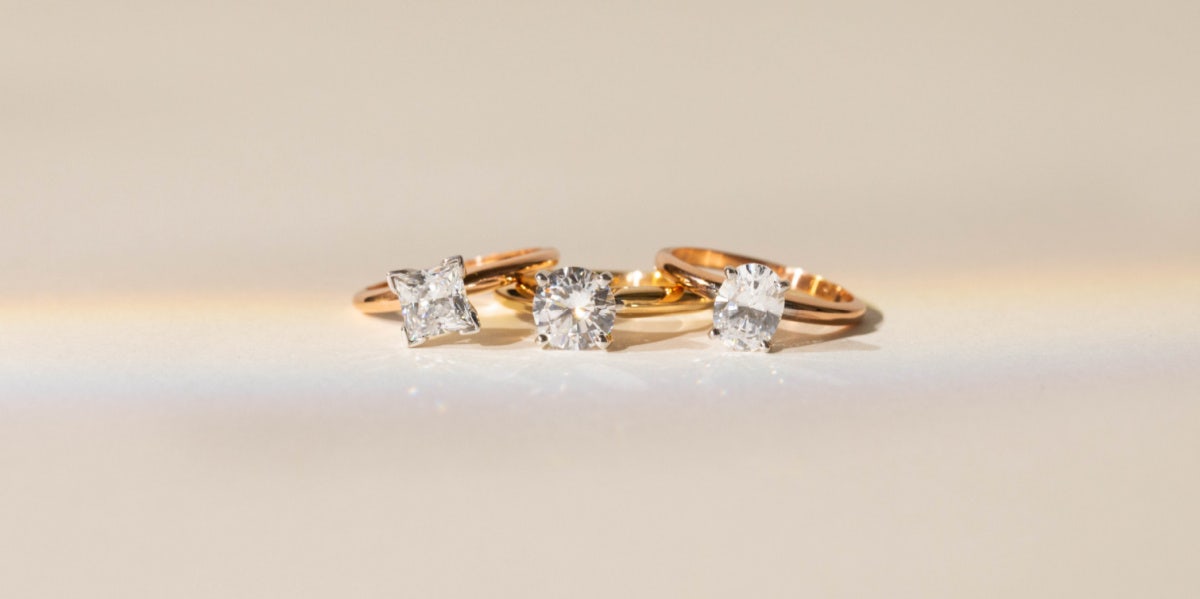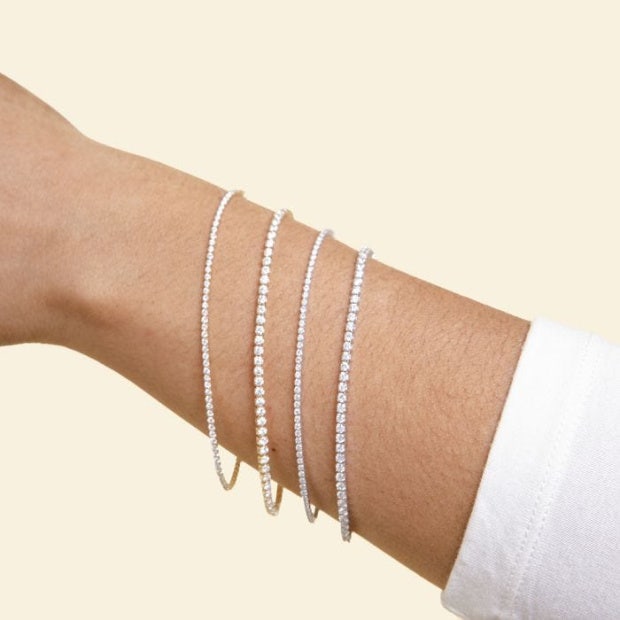Why Lab-Grown Diamonds Are Better Than 'The Real Deal' (And How To Choose One)
Lab-grown diamonds truly are a beautiful, ethical option.
 Clean Origin
Clean Origin The diamond industry has changed drastically in the last few decades — and that’s a good thing. From the first synthetic diamond that was created in 1954, the industry began to swing in a direction that wasn’t only less expensive, but both politically and ecologically sound.
Despite their beauty, some real diamonds come at a cost. Many people are involved in getting the diamond unearthed and to a jewelry store, and at the beginning of the pipeline are sometimes children who are forced into working in conditions unsuitable for any living thing, let alone a child.
Other diamonds, blood diamonds as they’re called, are harvested to finance civil wars. Even some that aren’t the product of political corruption can be the result of deforestation and the overall destruction of the ecosystem in which they were attained.
While steps have been made to make sure that the majority of diamonds are conflict-free, there’s still a percentage that are not.
With that in mind, companies have turned to diamond alternatives, like producing lab-created diamonds which are just as beautiful, but without the probability of being sourced under inhumane or environmentally detrimental locations.
To be part of this new frontier of diamonds and change the narrative of what these lab-created stones really are, Clean Origin, founded in 2017 by industry veterans, has created a wide variety of 100% ethical and 100% real diamonds for consumers to choose from.
Going beyond just engagement rings, Clean Origin also offers necklaces, bracelets, and earrings, as well as other diamond rings that aren’t just for popping the big question.
All their diamond products, because they are lab-grown, are ethically sourced and eco-friendly, as well as high-quality and competitively priced.
 Photo: Clean Origin
Photo: Clean Origin
Shop now on Clean Origin and receive free expedited and insured shipping!
If the thought of whether you, the consumer, or your friends and family can tell if your engagement ring or other jewelry are lab-created diamonds or mined diamonds, the short answer is no — at least not to the naked eye. The only way for someone to tell is to have the diamond tested.
But it should be noted that just because these diamonds are man-made in the lab, they’re not fake diamonds. Synthetic diamonds contain the same physical properties, chemical makeup and, of course, the visual appearance of what one might consider “real” — AKA, mined diamonds.
Lab-created diamonds are the real thing, they’re just made in a lab. They’re also just as valuable and, like mined diamonds, have a resale value that is equivalent to their original price. (Cubic zirconia and moissanite, on the other hand, are what would be categorized as “fake” diamonds.)
What are lab-grown diamonds?
As the name states, lab-grown diamonds are real diamonds grown in a lab using technology that replicates how diamonds are naturally made within the Earth.
There are two ways in which a lab can produce a diamond: High Pressure-High Temperature (HPHT) and Chemical Vapor Deposition (CVD). Each process entails the pressure and temperature necessary to create a diamond found in the Earth.
Once the diamond is made, they're sent to a specialist in a gem lab where each stone is logged in a grading report based on their carat weight, clarity, color, and cut. Then, they’re certified before being made available to consumers.
Lab-Grown Diamonds vs. Real or Mined Diamonds
The creation of a real diamond is hardly an overnight production. According to geologists, diamonds formed between 1 billion and 3 billion years ago, deep beneath the Earth’s crust.
Although these experts can’t pinpoint exactly how these gorgeous gems came to be, it’s their understanding that the process begins with carbon dioxide up to 100 miles into the Earth. While in that environment, the CO2 is put under extreme pressure — about 727,000 pounds per square inch — and it’s exposed to upwards of 2,200 degrees Fahrenheit.
Once in its diamond form, these beauties make their way to the Earth’s surface thanks to an eruption of magma that takes the diamonds along with it.
As for synthetic diamonds, they don’t take as long, for starters. Whether the HPHT or CVD process is used in diamond-producing in the lab, each gem starts as a diamond seed, and is pressurized and exposed to well over 1,000 degrees Fahrenheit.
These lab-grown diamonds then take less than a month to grow, based on their color, with white diamonds taking the longest.
Ultimately, and most importantly, synthetic diamonds and real diamonds have the same physical and chemical properties.
3 Reasons to Consider Lab-Grown Diamonds
Why consider lab-grown diamonds? Easy: you’ll sleep better at night knowing where your diamond came from.
Here are three important points to consider:
1. Lab-grown diamonds are ethical.
Considering the history of blood diamonds, the children used in excavating them, and the war zones in which they’re often found, choosing a lab-grown diamond just makes sense on a human level.
While you may never meet the children whose lives are negatively affected by the mined diamond industry, just knowing they exist should be enough to warrant a look inside your heart and to do the right thing.
2. Lab-grown diamonds are eco-friendly.
Our planet is in peril. As we watch climate change ravage the Earth due to the actions of humans, being conscious of the environment and how our purchases affect the environment isn’t just a responsible way of thinking, but necessary at this point.
With a lab-grown diamond, you know that no ecosystem has been altered just so you can have something shiny on your finger or around your neck.
3. Lab-grown diamonds are less expensive.
When you cut out that gigantic pipeline of people involved in mining diamonds and getting them to stores, your diamond automatically becomes less expensive.
But less expensive shouldn’t be linked to lower quality. If anything, you can be sure you’re getting a high-quality diamond because it is being monitored in a lab!
How to Choose the Best Lab-Grown Diamond for You
Well, first thing’s first: why are you buying the diamond? Clean Origin has diamonds and jewelry options for all occasions. Not that you need a special occasion for diamonds!
Here are three steps to finding the best lab-grown diamond for you:
1. Determine the occasion for purchasing a diamond.
Again, while you don’t need an occasion, the occasion can help you decide.
If you’re proposing, then naturally, you want an engagement ring. Clean Origin has a stunning selection of Art Deco engagement rings to wow your future spouse.
If it’s someone’s birthday, consider giving a tennis bracelet, like the Classic Tennis Bracelet or Petite Diamond Tennis Bracelet for the ideal gift.
 Photo: Clean Origin
Photo: Clean Origin
2. Consider to whom you'll be gifting a lab-grown diamond.
Of course, when it comes to choosing a diamond, who the gift is for plays a big role.
If it’s for a wedding anniversary, the Classic Emerald Eternity Band is an adorable way to show your adoration and love throughout the years.
If it’s for your daughter’s Sweet 16, the Soho Emerald Pendant is also a great choice as she’s less likely to lose something that’s around her neck.
 Photo: Clean Origin
Photo: Clean Origin
3. Think about your budget.
Depending on your budget, you may want to think about this before all else. But considering that lab-grown diamonds cost far less than if you were purchasing diamonds that had been mined, budget may not be the first thing to come up.
If you’re looking to treat yourself, just because you know you deserve it, a pair of diamond stud earrings may be just what you're looking for. The 4 Prong Diamond Studs as well as the Luminescent Halo Studs are also very affordable options that are just as breathtaking as any “real” diamond studs you’d drop thousands of dollars on!
 Photo: Clean Origin
Photo: Clean Origin
Clean Origin offers free shipping, financing, lifetime warranty, and free resizing!
But the options hardly stop there. Clean Origin has a wide variety of diamond products, including wedding and eternity bands, custom-built rings, loose lab-created diamonds, and wedding sets.
Plus, they offer virtual appointments to help get you started — no matter the occasion.
-Created in partnership with Clean Origin
Amanda Chatel is a New York City-based writer who has worked in both the ready-to-wear and haute-couture ends of fashion. She got her start at a jewelry design firm in NYC.

